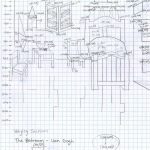The problem is solved by making a sketch on graph paper. Geometry problems are best solved by seeing the geometry. Without the sketch, you have nothing.
Elodie Fourquet Assistant Professor of Computer Science
Assistant Professor of Computer Science Elodie Fourquet teaches an unusual art course. First-year students in FSEM 131 don’t come with paintbrushes or chisels; they come with graph paper, pencils, and computers.
During the four-month term, students study the geometric structure of works of art, learning how picture elements in art can be defined mathematically and how they interact geometrically. They sketch the abstractions and designs they see in the art and then use their sketches to structure computer programs that represent and elaborate on the art they’ve been studying.
It’s an interdisciplinary experience, and to hear Fourquet or her students talk about it, it’s something magical.
“To me, an FSEM is a place where anything can happen,” Fourquet said. “Learning early on that they have creative freedom, my students are more open to the opportunities available in a liberal arts setting.”
Hayley Jackson ’22 concurs. “The class was unique because the students came from such different backgrounds,” she said. “Many students had experience in either art or computer science, so it was interesting to see the ways in which the class agreed and disagreed.”
Finished pieces produced in FSEM 131 range from electronic renditions of famous paintings to all-new digital creations and works with interactive, pop-out designs. Every shape and pattern is designed and programmed based on sketches and measurements made by the students.
FSEM131 introduces first-year students to the art in computer graphics, demonstrating how programs are structurally similar to the images that they create and encouraging interest in both programming and artistic design at Colgate. Art students learn skills that open up new design ideas; computer science students see the fascinating intersections between mathematics and art.
A gallery of art from FSEM 131 is available here. Fourquet plans to develop the course in future offerings, extending student opportunities for exploring the geometric interplay of visual art and graphics programming.
